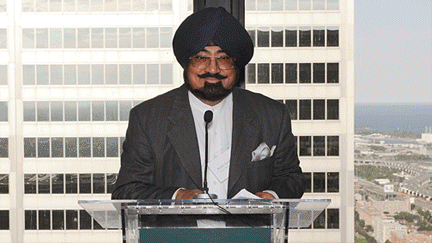The monumental challenge of carrying forward the unfinished tasks
December 16th, 2014
The new government headed by President Ashraf Ghani faces a monumental task of carrying forward the unfinished projects of the previous government that are critical to growth of Afghan economy
Notwithstanding the blistering criticism, many small and big economic development projects were executed by the previous government headed by Hamid Karzai. However, many projects were left incomplete. The new government headed by President Ashraf Ghani now faces a monumental task of carrying forward the unfinished work projects, which according to economic analysts are critical to fledgling economy of Afghanistan.
For Afghanistan to become economically self-sufficient, the execution of these important projects will play an instrumental role. Extraction of Ainak copper mine and Hajigak iron mine, construction of Kamal Khan dam, Salma hydroelectric and irrigation dam, execution of ambitious Turkmenistan-Afghanistan-Pakistan-India (TAPI) gas pipeline project, Kabul New City (KNC) project and various other tasks have been left to the national unity government led by President Ghani to carry forward complete.
These projects worth billions of USD, according to economic analysts, can propel the economic growth of Afghanistan and generate work opportunities for millions of people. According to conservative estimates, Afghanistan has over 1400 mineral fields, which account for more than 3 trillion USD in untapped mineral deposits. During his meeting with Indian businessmen in December 2013, former president Hamid Karzai claimed the mineral deposits are worth more than 30 trillion USD.
The U.S. Geological Survey (USGS) has worked closely with the Afghanistan Geological Survey (AGS) of the Afghanistan Ministry of Mines to collect information about the untapped non-fuel mineral resources of Afghanistan. According to their findings, the country has abundant non-fuel mineral resources, ranging from copper, iron, sulfur, bauxite, lithium etc.
There is enough water in Afghanistan to produce electricity and if Ministry of Energy and Water (MEW) is to be believed, there are ample opportunities of producing solar and wind power too. But according to officials in MEW, most of the 75 billion cubic meter water flows to neighboring countries like Iran, Pakistan and other Central-Asian countries. Experts believe if this water is controlled and used for agriculture, the gross income of Afghanistan will increase and job opportunities would also open up.
The over-dependence on foreign aid, believe economic analysts, is hindering the economic growth and progress of Afghanistan. The decade of transition starts this year and it is a golden opportunity for Afghanistan to become self-sufficient and reduce the dependence on international aid. For that, the execution of economic development projects started during the previous government is critical.
Ainak copper mine project Contract signed in: 2008 Investment: 5 billion USD Mineral resources: 12-20 million tons Contractor: Metallurgical Group Corporation (MCC), China Contract duration: 30 years With 240 million metric tons of ore at 2.3 percent copper content, the Ainak copper mine in Mohammad Agha district of central Logar province is unarguably the largest copper mine in the world. In May 2008, a contract for the development of Ainak mine was awarded to a consortium of two Chinese firms, Metallurgical Group Corporation (MCC). The 30-year lease was granted for 3 billion USD, making it the biggest foreign investment in the history of Afghanistan. According to experts, the income from the extraction of copper from this mine can be an important source of revenue for the Afghan government in future. According to Ministry of Mines and Petroleum, Ainak contains six million tons of copper (5.52 million metric tons). MCC will invest 2.898 billion in the mega project, which is expected to increase to five billion in future. Even though the contract has already been signed with the Afghan government, it has escaped public scrutiny due to high level of secrecy in terms and conditions of contract. There is also an ambiguity about opening and closing of the mine, and the guarantees mentioned in the contract, which many believe was not awarded in a fool-proof manner. Some fear the riches of Ainak mine might not be used in a meaningful way to bolster country’s economy. Based on the contract, MCC is obliged to pay 800 million USD as advance and shell out 400 million USD in taxes per year to the Afghan government. However, even six years after the contract was inked, the work has not been started. In August 2013, MCC requested the Afghan government to review the contract and free them of obligations to compensate the Afghan government and develop the area around the site in Logar. Economic analysts in Afghanistan said the amendments will not be in favor of Afghanistan. Rafiullah Sediqi, spokesperson in Ministry of Mines and Petroleum, refuses to comment on the status of project. He says the new government will take a decision on it. Analysts believe it is important for economic self-sufficiency of Afghanistan but there should be no amendment in the original contract as demanded by the Chinese firms. Hajigak iron mine project Contract signed in: 2011 Investment: 14 billion USD Mineral resources: 2 billion tons Contractor: Indian and Canadian Consortium of Companies Contract duration: 30 years Located at Hajigak in northern Bamyan province, and spread over the stretch of 32 km with 16 different zones, Hajigak mine is the largest iron oxide deposit in Afghanistan. The vast economical potential of Hajigak mine was recognized after a joint Afghan-Soviet study project between 1963 and 1965 mapped the extent of iron deposit in the mine. In November 2011, the Afghan government awarded three of the four blocks of Hajigak mine to seven Indian companies supported by Indian government. The contract for final block was awarded to a Canadian firm, Kilo Goldmines Ltd. (KGL). The Indian companies are supposed to build a power plant and invest 1 billion USD in a railroad to export the iron ore. Hajigak mine is likely to attract 14.6 billion USD in foreign investment over 30 years, including 10.7 billion USD from Indian companies led by state-owned Steel Authority of India Ltd. and NMDC Ltd. Hajigak mine contains an estimated 1.8 billion metric tons of ore, which the U.S. government recently said amounts for 1 trillion USD in untapped minerals. According to Ministry of Mines and Petroleum, the investment in Hajigaj is critical in developing Afghanistan’s vast mineral resources and sustaining economic growth. The work was supposed to begin a year after the contract was signed, but even three years later, there is no progress. In October 2013, the Indian consortium sought to renegotiate the terms of contract. The project has been put on backburner owing to security and other technical issues. The project might get delayed further with the change of guard in Kabul and proposed amendments in country’s mining laws. Indian consortium had adopted wait and watch approach so far. According to sources in SAIL, they are expecting Afghanistan to provide them basic rail-road facilities to transport the iron ore, besides fool-proof security. With new governments both in New Delhi and Kabul, the project might see headway in near future. According to Ministry officials, more than 30,000 people are likely to benefit from this lucrative business project. Salma Dam project Start of work: 2006 Investment: More than 300 million USD Contractor: Indian government Expected completion: 2014 Salma Dam, a hydroelectric and irrigation dam located on Hari River in western Herat province, was originally constructed in 1976. It suffered heavy damage during the years of civil war in Afghanistan. The reconstruction work on the damn was first taken up by an Indian company WAPCOS in 1988; however the project was suspended owing to security concerns. As part of its financial assistance for reconstruction and rebuilding in Afghanistan, Indian government pledged to invest 300 million USD on the damn in 2006. The work was supposed to complete before 2014. Earlier this year, India’s consular general in Heart expressed hope that the project would be completed this year. With the completion of project, the problem of irrigation and electricity will be solved. It will have the capacity to irrigate 75,000 acres of land and produce 42 megawatt electricity. The damn has been the target of many attacks in the past. In May last year, six security guards at the project site were killed in a roadside bomb explosion. According to security analysts, the attacks are a handiwork of foreign agents who are hell-bent to derail the process of development and reconstruction in Afghanistan and fight proxy war against India. With the new government in Kabul, the project is likely to complete this year. The new government in New Delhi has reiterated its commitment to financially assist Afghanistan. Kamal Khan Dam project Start of work: 2011 Investment: 100 million USD Contractor: Tades, Bright Pearl and Bana Construction Companies Expected completion: 2019 Kamal Khan Dam, being constructed over Helmand River in Nimroz province, about 95 kilometers from Zaranj city, is one of the important projects that remain incomplete. An agreement was signed between the Afghan government and Tajik firm Tades in December 2011 for construction work on the dam. Once the work is complete, it will irrigate about 40,000 acres of land and produce 8.5 megawatt electricity. The construction work, which amounts to 100 million USD, was planned in three stages. Tades was supposed to carry out the first stage of construction work on the dam over Helmand River in Nimroz province. Under the contract, Tades had to build and reconstruct transmission lines and hydroelectric facilities. The two Afghan firms, Bright Pearl and Asian Bana construction companies, were supposed to carry out the second stage of work on the dam. The first phase of work has been completed and the work on second phase in currently in progress, which is expected to take five more months, according to officials in Ministry of Water and Power. The third phase, according to officials, will take 4 years to complete. The project has also been embroiled in political controversies as Iran raised concerns over the construction of dam, claiming that the flow of water in Helmand River to Sistan province of Iran has decreased. Afghan government dismissed the concerns as baseless. Shujauddin Ziayee, Deputy Minister of Water and Power, says there are many more projects that can help Afghanistan generate electricity. These include Kokcha and Kunar Rivers which can produce 2,000 megawatt electricity. TAPI project Start of work: 2010 Investment: 7.6 billion USD Capacity: 33 billion square meters gas Expected completion: 2017 The Trans-Afghanistan pipeline, also known as Turkmenistan-Afghanistan-Pakistan-India (TAPI) gas pipeline, is a natural gas pipeline being developed by Asian Development Bank (ADB). Expected to complete in 2017, it will help in transportation of natural gas from Turkmenistan through Afghanistan into Pakistan and finally to India. The estimated expenditure on the project is 7.6 billion USD. The original project was envisaged by Pakistan and Turkmenistan in March 1995 when the two countries signed memorandum of understanding for a gas pipeline project. On 24 April 2008, Pakistan, India and Afghanistan entered into an agreement to buy natural gas from Turkmenistan. On 16 May 2012, the Afghan Parliament approved the agreement. The 1,735 kilometer pipeline will pass through Turkmenistan gas fields to Afghanistan. In Afghanistan, the gas pipeline will be constructed alongside the Kandahar-Herat highway in western Afghanistan, before it goes to Pakistan. Afghanistan, which is a central party to the agreement, will have the right to use 600 million to 5 billion cubic meters of gas, and earn almost 400 million USD a year in transit fee. The work on the project will officially start in 2015 and end in 2017, according to government officials. The new government in Kabul has to play an important role in ensuring the smooth execution of this project. Ring road project Start of work: 2001 Work progress: 90 percent complete Length of the road: 3362 km End of project: not clear The ring road being constructed across the country is another important project that will make commuting easier for people as it connects northern and southern provinces with Kabul. This road begins in Kabul, and passes through Parwan, Baghlan, Samangan, Balkh, Sheberghan, Maimana, Badghis, Herat, Farah, Helmand, Kandahar, Ghazni and Wrdak provinces, before leading back to Kabul. Work on this ambitious project started 13 years ago, soon after the intervention of international community. According to Afghan government officials, almost 90 percent work on the project is complete. The total cost of project could not be ascertained Total as many companies have bagged the contract for this massive project. It has nine border branches linked to Tajikistan, Uzbekistan, Turkmenistan and Pakistan. Ahmad Shah Wahid, Deputy Minister of Public Works, says only 10 percent work is remaining, which is 231 km stretch from Maimana to Badghis connecting with Herat. According to him, Asian Development Bank paid 475 million USD for the project which was being carried out by Turkish and American companies. Both the companies left midway. The new government must ensure the speedy completion of work on this ring road project, as promised during the election campaign. It will immensely help Afghan traders and businessmen to commute from one place to other without any hassles. Kabul new city project Project approval: 2009 Investment: 34 billion USD Contractor Company: JAIKA, Japan End of project: 16 years A multi-phased housing construction project, Kabul New City was conceptualized to address the issue of housing shortage in Kabul city, which is witnessing the explosion of population. Under the project, 500,000 housing units will be constructed and it is likely to generate more than 50,000 jobs as well. Approved under the Master Plan, the project will incur 34 billion USD over the period of 16 years. The project, first approved in 2009, will be carried out in three phases. Dehsabz City Development Authority (DCDA) is over-seeing the project and liaising with the government on behalf of private sector investors. The 740 square km site includes two major urban sub-centres, modern residential and commercial zones, centrally located parks and sports facilities for children. The new government must ensure this project like many other projects is not stalled midway.
Comments are closed.














